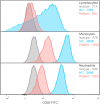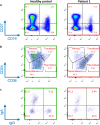CD55-deficiency in Jews of Bukharan descent is caused by the Cromer blood type Dr(a-) variant
- PMID: 35314883
- PMCID: PMC8936040
- DOI: 10.1007/s00439-021-02428-3
CD55-deficiency in Jews of Bukharan descent is caused by the Cromer blood type Dr(a-) variant
Abstract
The complement system regulator CD55 was initially found to carry the Cromer blood group system antigens, and its complete loss of function was subsequently revealed to cause a severe monogenic gastrointestinal syndrome characterized by protein-losing enteropathy and susceptibility to venous thrombosis. Here we present homozygosity to the CD55 c.596C>T; p.Ser199Leu variant, which was previously described as the Cromer Dr(a-) genotype, in two Bukharan Jewish CD55-deficiency patients with variable disease severity. We confirm that this missense variant causes aberrant splicing and deletion of 44 bp in exon 5, leading to premature termination and low expression of the CD55 protein. Furthermore, Patient 1 exhibited a mildly abnormal B cell immunophenotyping profile. By population screening we established that this variant is highly prevalent in the Bukharan Jewish population, with a carrier frequency of 1:17, suggesting that many similar patients are un- or mis-diagnosed. The phenotypic variability, ranging from abdominal pain when eating a high-fat diet to the full CD55-deficiency phenotype, is likely related to modifiers affecting the proportion of the variant that is able to escape aberrant splicing. Establishing the diagnosis of CD55-deficiency in a timely manner, even in patients with milder symptoms, may have a critical effect on their management and quality-of-life since treatment with the complement inhibitor eculizumab is highly effective in ameliorating disease manifestations. Awareness of founder mutations within certain populations can further guide genetic testing and prevent a diagnostic odyssey, by placing this CD55 variant high on the differential diagnosis.
© 2022. The Author(s), under exclusive licence to Springer-Verlag GmbH Germany, part of Springer Nature.
Conflict of interest statement
Authors AK and HBF have a patent with Alexion Pharmaceuticals on eculizumab treatment protocol for CD55-deficiency (WO/2018/217638), which does not include any royalties. Author HBF serves on the advisory board for the C5-inhibitor Pozelimab clinical trial by Regeneron Pharmaceuticals. All other authors have nothing to declare.
Figures




Similar articles
-
Severe early-onset Wilson disease caused by a common pathogenic variant in the Bukharan Jewish population in Israel.Gene. 2023 Dec 15;887:147728. doi: 10.1016/j.gene.2023.147728. Epub 2023 Aug 25. Gene. 2023. PMID: 37634880
-
The Cromer blood group system: an update.Immunohematology. 2021 Sep;37(3):118-121. doi: 10.21307/immunohematology-2021-017. Immunohematology. 2021. PMID: 34591381 Review.
-
Eculizumab Is Safe and Effective as a Long-term Treatment for Protein-losing Enteropathy Due to CD55 Deficiency.J Pediatr Gastroenterol Nutr. 2019 Mar;68(3):325-333. doi: 10.1097/MPG.0000000000002198. J Pediatr Gastroenterol Nutr. 2019. PMID: 30418410
-
CD55 Deficiency, Early-Onset Protein-Losing Enteropathy, and Thrombosis.N Engl J Med. 2017 Jul 6;377(1):52-61. doi: 10.1056/NEJMoa1615887. Epub 2017 Jun 28. N Engl J Med. 2017. PMID: 28657829 Free PMC article.
-
CHAPLE syndrome uncovers the primary role of complement in a familial form of Waldmann's disease.Immunol Rev. 2019 Jan;287(1):20-32. doi: 10.1111/imr.12715. Immunol Rev. 2019. PMID: 30565236 Review.
Cited by
-
Genetic disease risks of under-represented founder populations in New York City.PLoS Genet. 2025 Jun 24;21(6):e1011755. doi: 10.1371/journal.pgen.1011755. eCollection 2025 Jun. PLoS Genet. 2025. PMID: 40554605 Free PMC article.
-
Beyond IBD: the genetics of other early-onset diarrhoeal disorders.Hum Genet. 2023 May;142(5):655-667. doi: 10.1007/s00439-023-02524-6. Epub 2023 Feb 14. Hum Genet. 2023. PMID: 36788146 Free PMC article. Review.
-
Special issue: the genetics of early onset inflammatory bowel disease (IBD) and diarrheal disorders.Hum Genet. 2023 May;142(5):595-597. doi: 10.1007/s00439-023-02566-w. Hum Genet. 2023. PMID: 37106128 No abstract available.
-
Genetic disease risks of under-represented founder populations in New York City.medRxiv [Preprint]. 2024 Sep 28:2024.09.27.24314513. doi: 10.1101/2024.09.27.24314513. medRxiv. 2024. Update in: PLoS Genet. 2025 Jun 24;21(6):e1011755. doi: 10.1371/journal.pgen.1011755. PMID: 39399040 Free PMC article. Updated. Preprint.
References
MeSH terms
Substances
LinkOut - more resources
Full Text Sources
Miscellaneous

